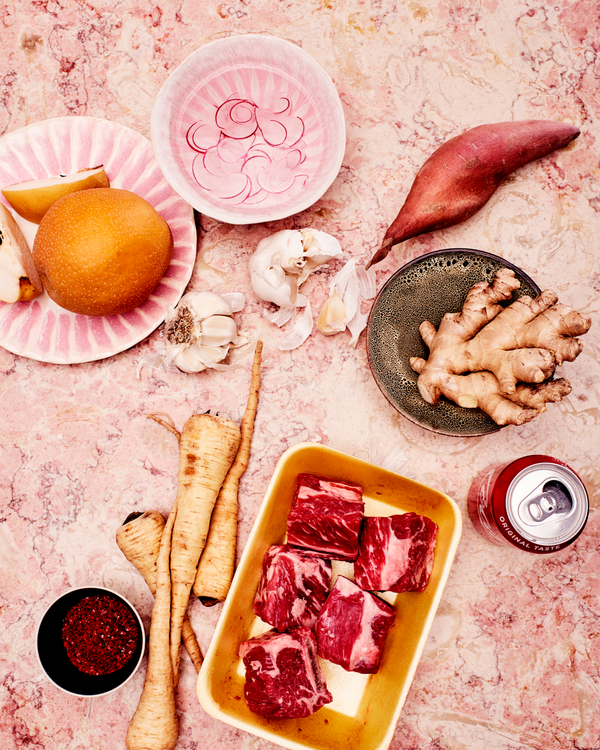No one makes better galbijjim than your mother, at least if she’s Korean and she’s following the usual script about this fragrant stew of short ribs and root vegetables. She boils the meat briefly, drains it off, then cooks it slowly in a pot filled with puréed Asian pear and mirin and soy sauce and brown sugar, garlic and onion, a lot of root vegetables. Everything bubbles away softly until the dish comes together in glossy, soft-shredded perfection. She serves the galbijjim with rice and kimchi. It tastes of home and innocence, though your friend may raise an eyebrow. Her mom’s version is better.
Galbijjim takes a lot of time, and short ribs are expensive, so she makes the dish only a few times a year — for birthdays, for holidays. You make the dish yourself from her instructions, and it doesn’t taste right. “You need to add rice syrup,” she might say in a whisper, revealing a secret. “You should have used apple juice. Where are the chestnuts?”
My mother is as Korean as Marge Simpson. But I’ve cooked or eaten versions of galbijjim made by plenty of Korean mothers’ children: Emily Kim, the online cooking star known as Maangchi; the Los Angeles chef and restaurateur Roy Choi; Hooni Kim, of Danji and Hanjan in New York; Esther Choi of the Brooklyn restaurant Mokbar. The closest I’ve come to feeling part of something larger than myself, as if I were now cooking a recipe and eating a dish I could pass along to others like a gift, was when I started eating and making the galbijjim that the chef Peter Cho serves at Han Oak, the restaurant he owns with his wife, Sun Young Park, in Portland, Ore.
I first had that galbijjim at a long communal table at Han Oak last fall, eating with my own family, a family-style meal, as Cho came out of the kitchen to bounce his son Frankie on his knee. It was revelatory: Each flavor was distinct and deeply burnished, as if assembled rather than stewed. Which turned out to be true, as it happens. For the restaurant, Cho smokes the short ribs before using them in the galbijjim; roasts his vegetables; adds fried rice cakes to sop up the jammy sauce; and swirls kale in at the end to add a bright note.

CreditPaola & Murray for The New York Times. Food stylist: Maggie Ruggiero. Prop stylist: Rebecca Bartoshesky.
“It’s less soupy than my mom’s,” he told me. He said he built his recipe out of memories of hers, though, along with a desire to ape the cooking of Korean barbecue restaurants in Los Angeles and New York and a chef’s need to balance textures and flavors, to make a dish larger than its components. “There are formulas to this stuff,” he said. “The fresh greens against the rich meat, for example. You do it long enough, and it begins to make sense.”
With Cho’s help, I set out to make his galbijjim at home, for a family rather than a restaurant service, without access to a smoker or a deep-fryer, or to the quince paste he uses to sweeten the braise in place of honey. At his suggestion, I didn’t boil the meat but roasted it above a collection of root vegetables under aggressive sprays of kosher salt and black pepper, on sheet pans so that everything could be spread out wide. All that surface area led to a lot of caramelization, to a depth of flavor that held through as the stew matured. Then, for the braise, I combined Asian pears and red onion, chicken stock, honey, soy sauce, rice-wine vinegar and plenty of red-pepper flakes, cooked it all down, then blitzed the mixture in a food processor to make a smooth and flavorful sauce. The roasted meat went into this concoction for more than an hour, bubbling along until it was tender and starting to flake from the bone.
The root vegetables followed. And then the rice cakes, hungry for sauce. And Cho was right about the greens, which I added at the very end. Barely softened by the heat, they served to offset the deep, unctuous quality of the short ribs, the chewiness of the rice cakes. They provided a perfect equilibrium.
Of course Cho’s recipe had a secret ingredient. He is an exacting, technical chef, who trained under April Bloomfield at the Spotted Pig in New York and ran the kitchen at the Breslin for her before moving home to Portland to be closer to family and finding fame at Han Oak. His cooking is precise and beautiful; he serves his poached cod with charred scallions and mushroom broth, with chanterelles, below dots of laboriously made herb oil. He has lots of secrets. Here is one of them. To the braising liquid for the short ribs, he told me early on, you want to add a can of Coke. He offered the advice to do that the way a mother might, with a shrug. It was not wrong. “I’m not sure you’ll even taste it,” Cho said, accurately. “But it’s kind of got to be in there.”
Recipe: Han Oak Galbijjim




